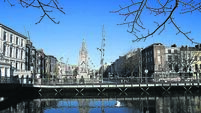A Cork commuter’s story: Five reasons to swap car for train

It doesn’t involve a health guru, enormous sacrifice, or even participation in a national televised weight loss programme. It’s a public transport transformation and the rules are easy. Take the train!
Towards the end of last year, my dear hairdresser Ruth, who is as good at conversation as she is at wielding a pair of scissors, was bemoaning the traffic in Cork.
Living in Carrigtwohill, it was taking her an hour and a half to drive to work in the city centre. She said some mornings the traffic was so bad it was backed all the way up to the Carrigtwohill roundabout to join the N25. It was as bad going home and she was despairing.
She was unconvinced.
Well, that was a few months ago and since then Ruth has become a full on train convert. We spent my last haircut/chinwag mostly talking about the joy of the Cobh-Cork commuter train, and her praise was so effusive and her life so transformed by the simple act of leaving her car in the driveway every morning, I asked could I share her story.
So, with Ruth’s permission, here are the top five things about taking the train that might transform your life.
The train from Glounthaune to Cork Kent takes 12 minutes!
I kind of didn’t believe her, but yes, there is a train almost every 15 minutes which will deliver you to the city centre in less than a quarter of an hour, with enough time to get to your desk or salon by 9am.
It takes Ruth 20 minutes to walk to the Glounthaune station, a walk she thoroughly enjoys (see below). Add on 12 minutes for the journey to Kent Station and another 20 minute walk to her final destination and her commute takes 52 minutes. Let’s call it an hour.
Compared to the 1.5 hours spent driving, she’s gained 30 minutes a day. That’s 2.5 hours a week of her life not spent stressed, sitting in a driver’s seat with a twitchy knee working the clutch. (For any nitpickers, her return journey driving used take an hour so no time gain there)
She is saving €50 a week on fuel and parking costs. That is going straight into a newly purchased piggy bank and if she takes the train for 50 weeks of the year, she’ll have €2,500 truffled away to spend on something much more pleasant than staring at the rear end of a car on the Dunkettle interchange .
It’s not surprising, but walking 80 minutes a day has massive health benefits. This is what urban planners and policymakers like to call ‘active travel’.
Exercise doesn’t have to be a sweat-athon or death march, just a 20 minute walk to the train station, followed by 20 minutes to work and repeat for the return journey. Hey presto, you’ve clocked up 80 minutes of walking.
Ruth has lost 5 pounds without counting a step or calorie.
Again, this is not surprising, but eliminating a major, daily source of stress - the angst at being powerlessly stuck in traffic unsure if you’ll make it to work on time - is good for your mood.
Eighty minutes of daily exercise plus not listening to the constant bad news cycle on the radio are more positive ticks for good mental health.
Travelling by train creates a sense of community. Seeing the regulars get on board, walking through the city centre, picking up the atmosphere of the people and businesses, builds a feeling of connection to the city and is another mood enhancer.
Everyone is aware of the climate crisis and the urgent need for massive changes. You might think Ruth’s story is insignificant but leaving the car at home after decades of driving it to work is a major shift.
Not everyone lives next to a well serviced train line to make that leap, but many East Cork residents could, helping to save the planet while saving themselves from the pain of traffic.
I wrote a few weeks ago about the uplifting splash of yellow delivered by this year’s bloom of daffodils, and now the dandelions have arrived in numbers. Explosions of yellow on road verges, paths, gardens, a broken piece of footpath (you’ve got to admire a dandelion’s ability to grow on the scrappiest bit of soil) are everywhere.
Long lamented as a weed to be eradicated by zealous gardeners, the message that dandelions are in fact critical for the bee population and are to be welcomed and encouraged as an important source of food for emerging bees at this time of the year has caught on.
Why would you want a generic green lawn when you could have a cheerful yellow carpet of dandelions set off with clumps of friendly daisies? I know that sentence might make a traditional gardener shudder, but for the less fastidious owners of gardens (like me), dandelions and bees are the best excuse to do absolutely nothing and let nature do her thing.







 App?
App?




